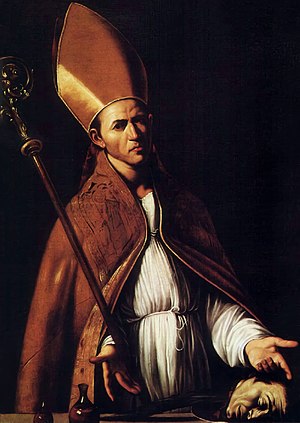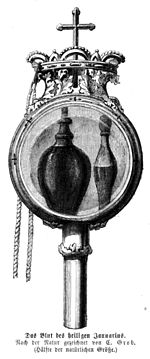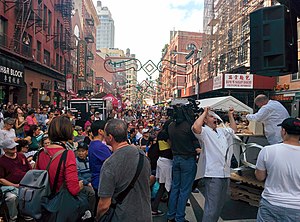
Nolita, sometimes written as NoLIta and deriving from "North of Little Italy", is a neighborhood in the borough of Manhattan in New York City. Nolita is situated in Lower Manhattan, bounded on the north by Houston Street, on the east by the Bowery, on the south roughly by Broome Street, and on the west by Lafayette Street. It lies east of SoHo, south of NoHo, west of the Lower East Side, and north of Little Italy and Chinatown.

Little Italy is a neighborhood in Lower Manhattan in New York City, known for its Italian population. It is bounded on the west by Tribeca and Soho, on the south by Chinatown, on the east by the Bowery and Lower East Side, and on the north by Nolita.
A patronal feast or patronal festival is a yearly celebration dedicated – in countries influenced by Christianity – to the 'heavenly advocate' or 'patron' of the location holding the festival, who is a saint or virgin. The day of this celebration is called patronal feast day, patronal day or patron day of said location.

Public holidays in Italy are established by the Italian parliament and, with the exception of city or community patronal days, apply nationwide. These include a mix of national, religious and local observances. As for Whit Monday, there is an exception for South Tyrol. In Italy there are also State commemoration days, which are not public holidays.

Januarius, also known as Januarius I of Benevento, was Bishop of Benevento and is a martyr and saint of the Catholic Church and the Eastern Orthodox Church. While no contemporary sources on his life are preserved, later sources and legends claim that he died during the Great Persecution, which ended with Diocletian's retirement in 305.

Pozzuoli is a city and comune of the Metropolitan City of Naples, in the Italian region of Campania. It is the main city of the Phlegrean Peninsula.

Mulberry Street is a principal thoroughfare in Lower Manhattan, New York City, United States. It is historically associated with Italian-American culture and history, and in the late 19th and early 20th centuries was the heart of Manhattan's Little Italy.
Saint Proculus (Proclus) of Pozzuoli was martyred around 305 AD, according to Christian tradition, at the same time as Saint Januarius.

The Naples Cathedral, or Cathedral of the Assumption of Mary, is a Roman Catholic cathedral, the main church of Naples, southern Italy, and the seat of the Archbishop of Naples. It is widely known as the Cathedral of Saint Januarius, in honour of the city's patron saint.
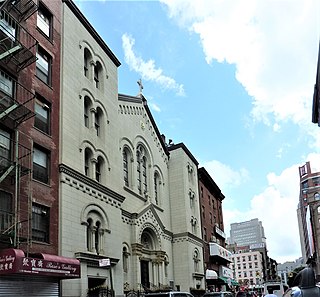
The Church of the Most Precious Blood is a Roman Catholic parish located in New York City. The parish is under the authority of the Archdiocese of New York, and is the National Shrine Church of San Gennaro. Located at 113 Baxter Street with an additional entrance on Mulberry Street, the Church of the Most Precious Blood is part of Manhattan's Little Italy neighborhood. The Most Precious Blood parished merged with Old St. Patrick's Cathedral parish, and the two churches share priests and administrative staff.
Little Italy, Connellsville is an area on the west side of Connellsville, in Fayette County, Pennsylvania.
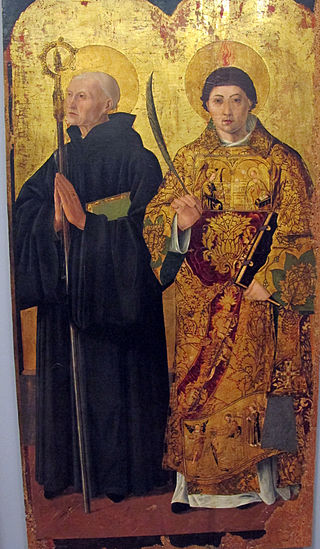
Saint Sossius or Sosius was Deacon of Misenum, an important naval base of the Roman Empire in the Bay of Naples. He was martyred along with Saint Januarius at Pozzuoli during the Diocletian Persecutions. His feast day is September 23, the date, three days after his death, on which his corpse was translated to Misenum.

San Vincenzo Martire di Craco is a minor saint of the Roman Catholic Church. He is remembered in devotions by the people of Craco in the province of Matera, the Basilicata Region, Italy along with immigrants and their descendants from that town who settled in North America. San Vincenzo Martire di Craco's feast day is celebrated on the fourth Sunday of October in Craco, Italy and Manhattan, New York.

Christianity and religion in general has always been an important part of the social and cultural life of Naples. It is the seat of the Archdiocese of Naples, and the Catholic faith is highly important to the people of Naples and there are hundreds of historic churches in the city. The Cathedral of Naples is the most important place of worship in the city, each year on September 19 it hosts the Miracle of Saint Januarius, the city's patron saint. In the miracle which thousands of Neapolitans flock to witness, the dried blood of Januarius is said to turn to liquid when brought close to relics said to be of his body: this is one of the most important traditions for Neapolitans.

The Royal Chapel of the Treasure of St. Januarius, or the Reale cappella del Tesoro di San Gennaro, is a chapel located in the Cathedral of Naples, Italy, and dedicated to St. Januarius, patron saint of the city. This is the most lavishly decorated chapel in the cathedral, and contains contributions by the premier Baroque artists in Naples.

Traditions of Italy are sets of traditions, beliefs, values, and customs that belongs within the culture of Italian people. These traditions have influenced life in Italy for centuries, and are still practiced in modern times. Italian traditions are directly connected to Italy's ancestors, which says even more about Italian history.

Our Lady of Miracles is the patron saint of the town of Alcamo.
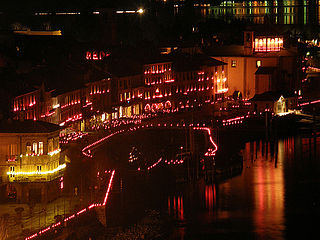
The Holy Piety feast is a catholic feast celebrated on 7 January evening in Cannobio.
San Gennaro usually refers to St Januarius, bishop of Naples.

Saint Januarius in the Amphitheatre at Pozzuoli is a 1635-1637 oil on canvas painting by Artemisia Gentileschi. The work shows the moment that the Christian martyr Januarius and his followers are thrown to a group of wild animals in the amphitheatre in Pozzuoli - however, they lick the saint's feet rather than attacking him and Januarius is unharmed.
